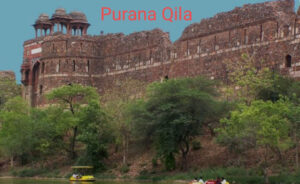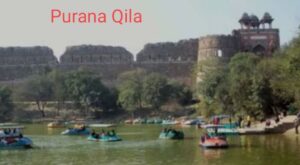Purana Qila, or the Old Fort, stands as one of the oldest and most iconic historical landmarks in Delhi. Situated near the banks of the Yamuna River, this fortress has witnessed the rise and fall of several dynasties, from the ancient rulers of Indraprastha to the Mughals and later the British colonialists. With its impressive architecture, cultural significance, and timeless appeal, Purana Qila offers a glimpse into India’s rich heritage. In this post, we will explore the fort’s fascinating history, stunning architectural features, cultural significance, and its role as a modern-day tourist attraction.

1: History of Purana Qila
• Ancient Origins
Purana Qila is believed to be located on the site of the ancient city of Indraprastha, the legendary capital of the Pandavas mentioned in the Mahabharata. This association with India’s ancient epic gives the fort a special significance, as it is said to be one of the oldest continuously inhabited locations in the world. While there is no conclusive archaeological evidence directly linking the fort to the Mahabharata, excavations conducted at the site have revealed arti facts and structures dating back to the Mauryan period, supporting its ancient roots.
• Mughal Legacy
The present structure of Purana Qila was constructed during the reign of Sher Shah Suri in the 16th century. After defeating Humayun, the Mughal emperor, Sher Shah Suri began the construction of the fort to establish his dominance. However, after his untimely death, Humayun regained control and continued the fort’s construction, incorporating many features that reflected the grandeur of Mughal architecture. The fort became a symbol of Mughal power and was a strategic stronghold during their reign.
• Role in Indian History
Over the centuries, Purana Qila has played a pivotal role in shaping Indian history. It served as a refuge for Mughal emperors during times of war and was later used by the British during the colonial era. During the Indian Rebellion of 1857, the fort became a strategic military post for the British forces. Its connection to multiple historical events over different eras makes Purana Qila a crucial site for understanding India’s rich history.
• Archaeological Discoveries
Archaeological excavations at Purana Qila have revealed various layers of history. The findings include pottery, coins, and other artifacts from different historical periods, including the Gupta, Maurya, and Mughal eras. These discoveries, undertaken by the Archaeological Survey of India (ASI), provide further evidence of the fort’s ancient past and its significance as a cultural and historical center.
2: Architectural Marvels of Purana Qila
• Fort Design
Purana Qila’s architecture is a testament to the fusion of different architectural styles, particularly Indo-Islamic influences. The fort is spread over 1.5 kilometers and features three monumental gates—Bada Darwaza (the main entrance), Humayun Gate, and Talaq Gate. Each of these gates showcases a blend of red sandstone and marble, adorned with intricate carvings and calligraphy. The walls of the fort, with their massive battlements and imposing bastions, reflect the defensive prowess of medieval fortifications.
• Qila- i- Kuhna Mosque
One of the architectural gems within Purana Qila is the Qila- i- Kuhna Mosque, built by Sher Shah Suri. This mosque is an excellent example of Indo-Islamic architecture, combining Islamic motifs with Indian craftsmanship. The mosque features a large prayer hall, adorned with intricate geometric patterns, calligraphy, and inlaid marble. The central mihrab is particularly impressive, showcasing detailed tile work that highlights the architectural sophistication of the era.
• Sher Mandal
Sher Mandal is another significant structure within the fort complex. This two-story octagonal pavilion was originally built by Sher Shah Suri and later used by Humayun as a library and observatory. Tragically, it was here that Humayun met his end when he slipped on the steps while carrying books and fell to his death in 1556. Sher Mandal’s red sandstone façade, along with its elegant balconies and domed roof, reflects the refined aesthetics of Mughal architecture.
• Water Management
The presence of a Baoli (stepwell) inside the fort complex highlights the advanced water management systems of the time. The stepwell not only served as a source of water for the fort’s inhabitants but also as a place of social gathering. The design of the Baoli is simple yet functional, emphasizing the importance of water conservation in medieval architecture.
• Materials and Techniques
Purana Qila’s construction primarily features red sandstone, a material favored by Mughal builders for its durability and aesthetic appeal. The use of marble in some of the more ornate sections, like the mosque and gates, adds to the fort’s grandeur. The techniques used in building the fort, such as the precision of the stone carvings and the intricate latticework, demonstrate the high level of craftsmanship during the Mughal period.

3: Cultural Significance of Purana Qila
• Purana Qila in Indian Literature
As the supposed site of Indraprastha, Purana Qila holds a special place in Indian literature and mythology. References to Indraprastha in the Mahabharata add a layer of cultural and historical depth to the fort. While the direct connection between the fort and the epic remains speculative, the association has made Purana Qila a symbol of IIndia’s ancient cultural heritage.
• Purana Qila as a Filming Location
Purana Qila has also become a popular filming location for Bollywood movies and television shows due to its historical ambiance and striking architecture. Its majestic gates, imposing walls, and scenic surroundings make it an ideal backdrop for period dramas and historical films. Movies like *Rang De Basanti* have featured scenes shot at the fort, contributing to its cultural visibility in modern India.
• Cultural Events Today
In addition to its historical significance, Purana Qila is a vibrant cultural hub. It hosts several events throughout the year, including theater performances, heritage festivals, and light-and-sound shows that depict the fort’s historical journey. The light-and-sound show, in particular, is a popular tourist attraction, bringing the fort’s history to life through dramatic narration and visual effects. These events highlight the fort’s enduring relevance in modern Delhi’s cultural landscape.
• Connection with Modern Delhi
Despite being centuries old, Purana Qila sits amidst the bustling metropolis of modern Delhi, serving as a bridge between the city’s ancient past and its dynamic present. The fort’s location near important landmarks like India Gate, Pragati Maidan, and the Delhi Zoo makes it a key tourist attraction. Its presence amidst the modern cityscape serves as a reminder of Delhi’s layered history.

4: Archaeological and Tourism Attractions
• Excavation Site
Purana Qila’s rich archaeological significance is evident from the numerous excavation sites within the fort complex. These excavations have uncovered ancient artifacts, pottery, and structural remnants that offer insights into the early civilizations that inhabited the area. The ongoing archaeological work continues to reveal new discoveries, deepening our understanding of Delhi’s historical evolution.
• Purana Qila Museum
Located within the fort, the Purana Qila Museum houses a collection of artifacts and historical exhibits that span various periods of Indian history. The museum showcases sculptures, coins, inscriptions, and pottery, providing visitors with a comprehensive understanding of the fort’s significance. The museum also features information on the archaeological discoveries made at the site, making it an educational stop for history enthusiasts.
• Boating Experience
A unique feature of Purana Qila is the boating experience offered at the lake adjacent to the fort. Visitors can enjoy a peaceful boat ride while taking in the scenic views of the fort’s imposing walls and lush surroundings. This recreational activity adds to the fort’s appeal, especially for families and tourists looking for a relaxing experience amidst historical ruins.
• Visiting Information
Purana Qila is open to visitors throughout the week, with an entry fee that is nominal compared to other historical sites in Delhi. The best time to visit is during the cooler months, from October to March, when the weather is pleasant for exploring the fort and its surroundings. Nearby attractions like the Delhi Zoo, Humayun’s Tomb, and India Gate make it easy to plan a full day of sightseeing in the area.
5: Purana Qila’s Importance in Modern-Day India
• A Monument of National Importance
Purana Qila is classified as a monument of national importance by the Archaeological Survey of India (ASI), which is responsible for its maintenance and preservation. The fort’s status as a protected site ensures that its historical and architectural integrity is preserved for future generations.
• Historical Preservation and Challenges
Despite its protected status, Purana Qila faces several challenges in terms of preservation. Urbanization, pollution, and the wear and tear of time have taken a toll on the fort’s structures. Ongoing restoration efforts by the ASI aim to address these issues, but maintaining such an expansive site requires significant resources and continuous attention.
• Symbol of Indian Heritage
Purana Qila stands as a powerful symbol of India’s rich cultural heritage. It embodies the layers of history that have shaped Delhi over millennia, from ancient civilizations to the Mughal Empire and beyond. As a living monument,Purana Qila continues to serve as a reminder of India’s diverse past and its resilience through various eras of conflict, conquest, and transformation. It remains an important icon of national pride, symbolizing the country’s deep-rooted history and architectural grandeur. The fort, with its storied past, reflects India’s ability to blend the ancient with the modern, showcasing how historical heritage can co-exist with contemporary life.
• Educational Value
Purana Qila is more than just a tourist attraction; it is a significant site for historians, archaeologists, students, and academics interested in India’s vast and complex history. The ongoing archaeological research offers new insights into India’s early civilizations, shedding light on the people who lived and thrived in this region centuries ago. The fort’s architecture and artifacts provide valuable learning opportunities for students of history, archaeology, and architecture. Educational tours to the site are common, as the fort serves as an open-air museum, where visitors can connect with India’s past in a tangible way.
Conclusion:
Purana Qila stands as one of the most fascinating historical sites in Delhi, representing centuries of Indian history, culture, and architecture. From its association with the ancient city of Indraprastha to its role in the Mughal Empire and its present status as a protected monument, Purana Qila offers a rich and immersive experience for history enthusiasts, tourists, and culture lovers alike. Its architectural splendor, cultural significance, and modern-day attractions, such as the museum and boating experience, make it a must-visit destination in the capital city of India.
Whether you’re intrigued by the myths of the Mahabharata, the legacy of the Mughal Empire, or simply enjoy exploring historical sites, Purana Qila has something to offer. Its connection to India’s past, combined with its relevance in modern Delhi, ensures that this ancient fort remains a timeless symbol of India’s enduring history. For those looking to explore Delhi’s heritage, Purana Qila is not to be missed.
FAQs:
1.Was Purana Qila built by Sher Shah Suri?
2.Which metro station is near to Purana Qila Delhi?
3.How old is Purana Quila?
4.What is the ticket price of Purana Qila?
5.Purana Qila was built by which ruler
6.Purana Qila nearest metro
7.5 lines on Purana Qila
8.Purana Qila wikipedia
9.Purana qila timing
10.Purana Qila architecture

